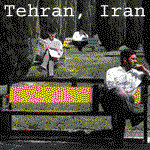"Pay the Bonus"
 “Keep the Home Fires Burning;" is the song under the photograph, which was a propaganda tune from World War 1. If one also notices the upper part of the newspaper article header, one will also see that the harshness of segregation or racism between white and black American’s was still being enforced during this time period.
“Keep the Home Fires Burning;" is the song under the photograph, which was a propaganda tune from World War 1. If one also notices the upper part of the newspaper article header, one will also see that the harshness of segregation or racism between white and black American’s was still being enforced during this time period.The Bonus March on Washington
The self-named Bonus Expeditionary Force was an assemblage of some 43,000 marchers — 17,000 World War I veterans, their families, and affiliated groups, who protested in Washington, D.C., in spring and summer of 1932. Called the Bonus March by the news media, the Bonus Marchers were more popularly known as the Bonus Army. The war veterans sought immediate cash payment of Service Certificates granted to them eight years earlier via the Adjusted Service Certificate Law of 1924. Each Service Certificate, issued to a qualified veteran soldier, bore a face value equal to the soldier's promised payment, plus compound interest. The problem was that the certificates (like bonds), matured twenty years from the date of original issuance, thus, under extant law, the Service Certificates were un-redeemable until 1945.
The Bonus Army was led by Walter W. Waters, a former Army sergeant, and was encouraged in their demand for immediate cash-payment redemption of their service certificates by retired U.S.M.C. Maj. Gen. Smedley Butler, one of the most popular military figures of the time.
In 1924, over-riding President Calvin Coolidge's veto, Congress legislated compensation for veterans to recognize their war-time suffering: receive a dollar for each day of domestic service, to a maximum of $500; and $1.25 for each day of overseas service, to a maximum of $625. Amounts owed of $50 or less were immediately paid; greater sums were issued as certificates of service maturing in 20 years.
Some 3,662,374 military service certificates were issued, with a face value of $3.638 billion. Congress established a trust fund to receive 20 annual payments of $112 million that, with interest, would finance the $3.638 billion dollars owed to the veterans in 1945. Meanwhile, veterans could borrow up to 22.5% of the certificate's face value from the fund. In 1931, because of the Great Depression, Congress increased the loan value to 50 per cent of the certificate's face value; yet, by April 1932, loans amounting to $1.248 billion dollars had been paid, leaving a $2.36-billion-dollar deficit. Although there was Congressional support for the immediate redemption (payment) of the military service certificates, President Hoover and Republican congressmen opposed that, because it would negatively affect the Federal Government's budget and Depression-relief programs. Meanwhile, veterans organizations pressed the Federal Government to allow the early redemption of their military service certificates.
 Bonus Marchers In Washington
Bonus Marchers In WashingtonOriginal caption: Bonus March on Washington, July, 1932. Veterans cheer Rep. Fish who was in Favor of bill to pay soldier's bonus, after they were ordered off capital steps.
 Bonus Veterans Crouch Beneath Banner
Bonus Veterans Crouch Beneath BannerOriginal caption: 6/19/1932-Washington, DC- "We need cash not a tombstone, pay the bonus now," says the sign these veterans from Muncie, Indiana display. And the Muncie contingent is just one of the many who say they will remain in the capital until the bonus is paid them.

"I was horrified to see plain evidence of hunger in their faces."
 Shacks, put up by the Bonus Army on the Anacostia flats, Washington, DC, burning after the battle with the military, 1932.
Shacks, put up by the Bonus Army on the Anacostia flats, Washington, DC, burning after the battle with the military, 1932. The U.S. Army intervenes
At 4:45 p.m., commanded by Gen. Douglas MacArthur, the 12th Infantry Regiment, Fort Howard, Maryland, and the 3rd Cavalry Regiment, supported by six battle tanks commanded by Maj. George S. Patton, Fort Myer, Virginia, formed in Pennsylvania Avenue while thousands of Civil Service employees left work to line the street and watch the U.S. Army attack its own veterans. The Bonus Marchers, believing the display was in their honour, cheered the troops until Maj. Patton charged the cavalry against them — an action which prompted the Civil Service employee spectators to yell, "Shame! Shame!"
After the cavalry charge, infantry, with fixed bayonets and adamsite gas, entered the Bonus Army camps, evicting veterans, families, and camp followers. The veterans fled across the Anacostia River, to their largest camp; President Hoover ordered the Army assault stopped, however, Gen. MacArthur—feeling this free-speech exercise was a Communist attempt at overthrowing the U.S. Government—ignored the President and ordered a new attack. Hundreds of veterans were injured, several were killed — including William Hushka and Eric Carlson; a veteran's wife miscarried; and many other veterans were hurt.
The Posse Comitatus Act — forbidding civilian police work by the U.S. military — did not apply to Washington, D.C., because it is the federal district directly governed by the U.S. Congress (U.S. Constitution, Article I. Section 8. Clause 17). The exemption was created because of an earlier "Bonus March". In 1781, most of the Continental Army was demobilized without pay, two years later, in 1783, hundreds of Pennsylvania war veterans marched on Philadelphia, surrounded the State House wherein Congress was in session, and demanded their pay. The U.S. Congress fled to Princeton, New Jersey, and, several weeks later, the U.S. Army expelled the war veterans back to home, out of the national capital.
An infant, Bernard Myers, later died in the hospital after the incident but reports indicated the death was not caused by the evacuation of the BEF.
Casualties and Losses

Labels: Depression, Economy, History, Poverty, Propaganda, Racism, United States















0 Comments:
Post a Comment
<< Home